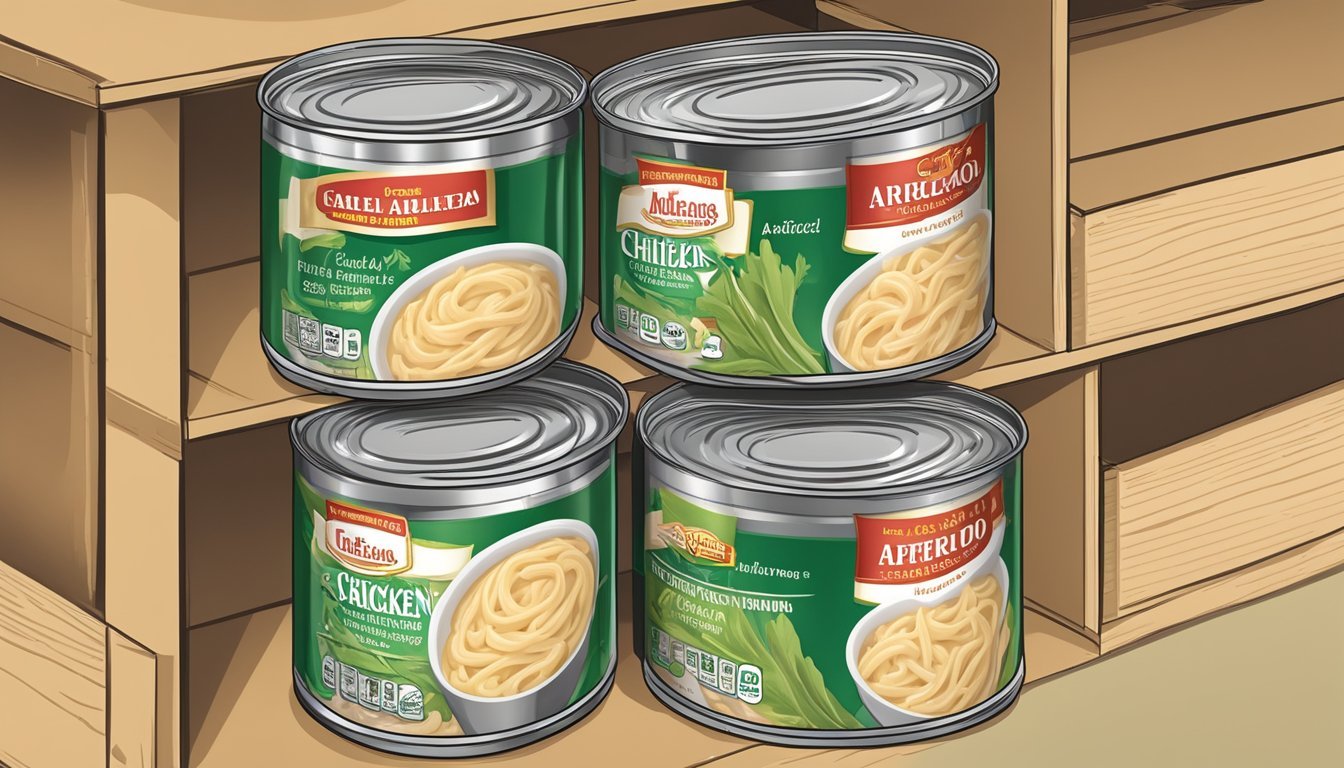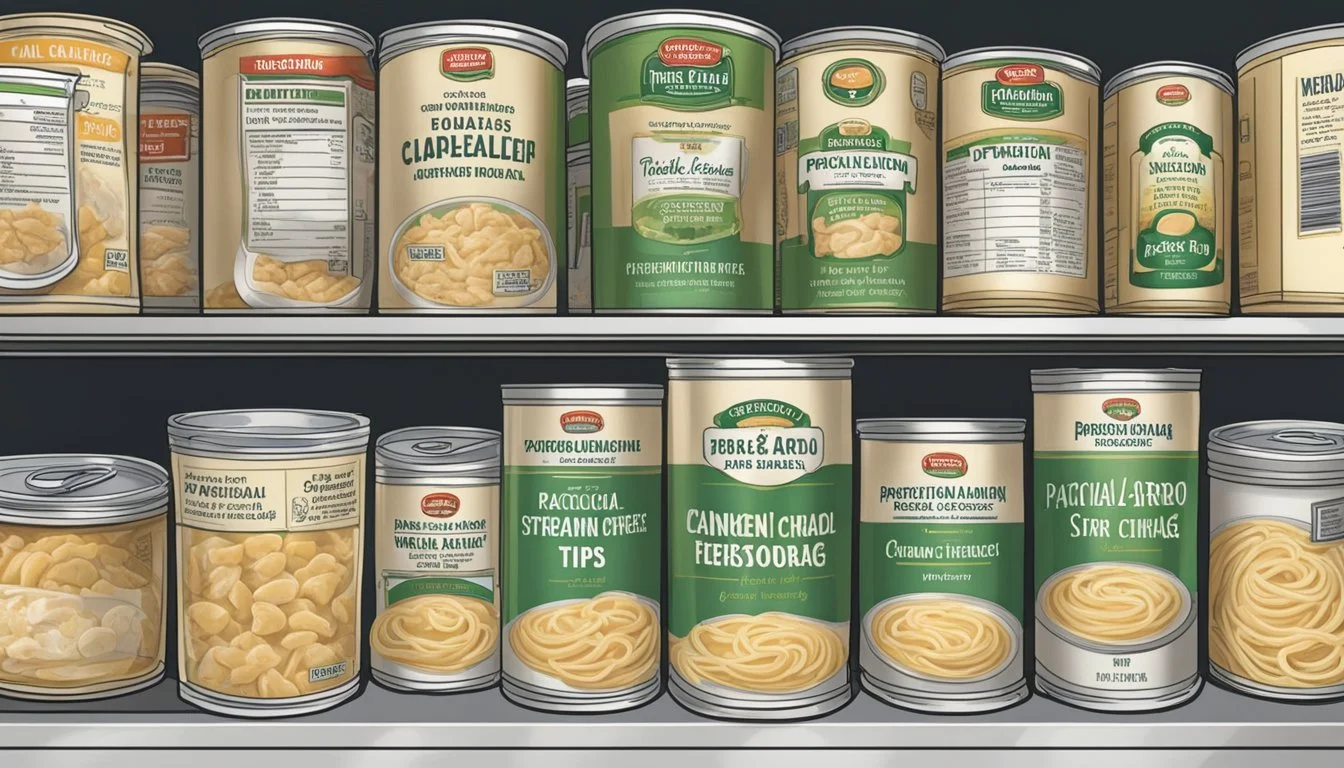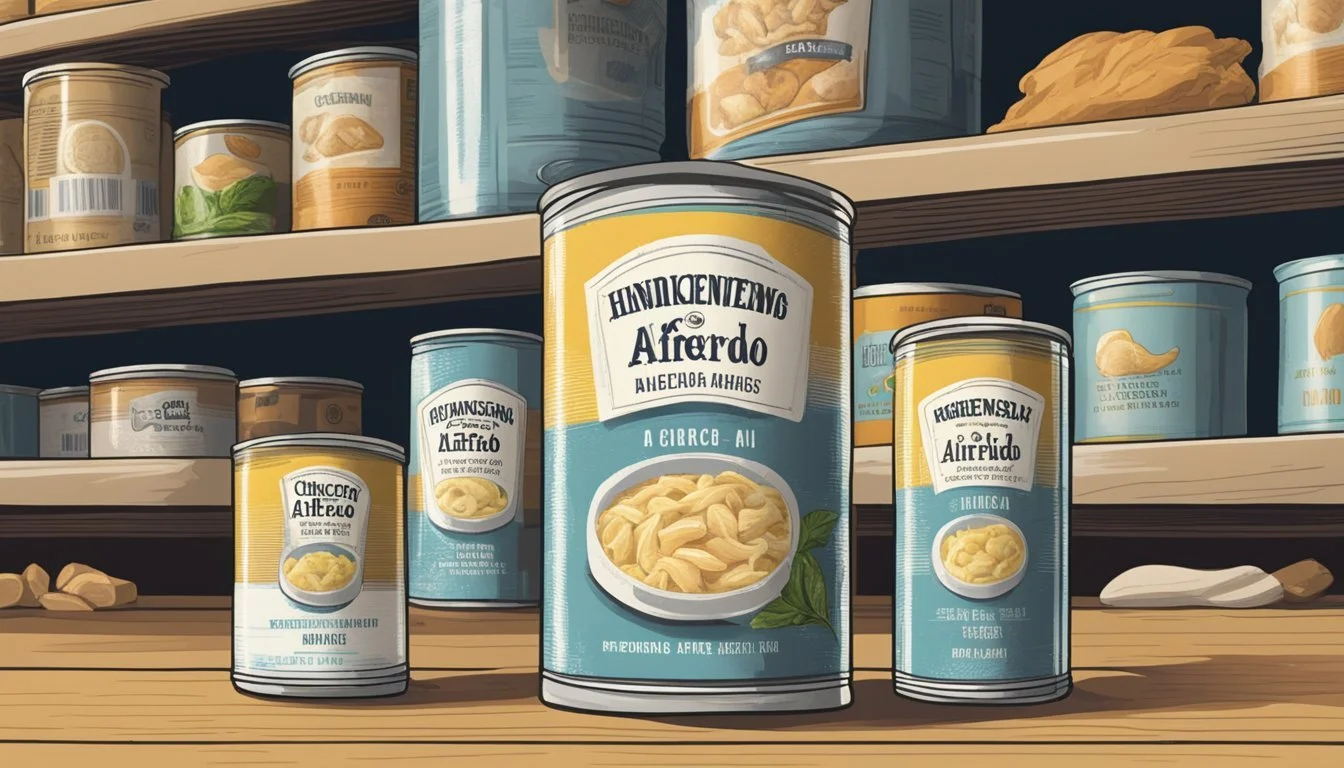Does Canned Chicken Alfredo Expire?
Shelf Life and Storage Tips
Canned chicken Alfredo is a convenient and tasty option for quick meals, but questions about its expiration date and shelf life often arise. Canned chicken Alfredo can generally be safely consumed for up to 3-5 years after the expiration date, provided the can is unopened and stored properly. This extended shelf life makes it a reliable pantry staple.
The expiration date on canned chicken Alfredo usually signifies the manufacturer's estimate of when the product will be at its best quality. While it may still be safe to eat after this date, the taste and texture might not be as good. If the can is compromised – dented, rusted, or bulging – it should be discarded regardless of the date.
Proper storage is crucial to maintaining the quality of canned chicken Alfredo. Storing the cans in a cool, dry place will help ensure they stay safe to eat for years. It's also advisable to inspect the product for any off smells or unusual appearances before consuming it, to ensure the best possible safety for you and your family.
Understanding Expiration Dates
Recognizing the differences among various date labels on food packaging is crucial for determining the shelf life and safety of canned chicken Alfredo. This section explains the distinctions between "Best-By," "Sell-By," and "Use-By" dates and how to interpret expiration dates on canned foods.
Differentiating Between 'Best-By,' 'Sell-By,' and 'Use-By'
Best-By Date: This date indicates the manufacturer's recommendation for when the product will be at its peak quality. After this date, the food might not taste as good or have the expected texture, but it’s typically still safe to eat.
Sell-By Date: The sell-by date is a guideline for retailers. It tells them how long the product can be displayed for sale. Foods usually remain safe to eat for some time after this date if stored properly.
Use-By Date: The use-by date is the last date recommended for using the product at its peak quality. While similar to best-by, use-by often has stricter safety implications, particularly for perishable items.
Interpreting Expiration Dates on Canned Foods
Canned foods, such as canned chicken Alfredo, differ from fresh and perishable items in how expiration dates apply. These dates often indicate the manufacturer’s assurance of quality rather than safety.
Quality vs. Safety: Even after the expiration date, canned foods can be safe to consume if the can is intact and stored properly. Quality might diminish, but safety usually remains uncompromised if there are no signs of spoilage, such as bulging cans or rust.
Storage Conditions: Proper storage conditions can extend the shelf life of canned foods. Keep them in a cool, dry place to maintain edibility for years beyond the expiration date. Check cans regularly for any damage or imperfections that could affect safety.
These guidelines help consumers make informed decisions, ensuring they consume food that is safe while minimizing waste.
Factors Influencing Shelf Life
Canned chicken Alfredo's shelf life depends on storage conditions, can integrity, and ingredients used. These factors determine how long the dish remains safe and palatable.
Impact of Storage Conditions
Proper storage is crucial for extending the shelf life of canned chicken Alfredo. Temperature acts as a significant factor; the can should be stored in a cool, dry place to minimize spoilage. Excessive heat speeds up the degradation process, while damp environments may promote rusting and contamination.
Pantry storage at stable room temperatures is ideal. Once opened, the product should be consumed within 1-3 days or refrigerated. For longer preservation, freezing is an option although it may affect texture and taste. Airtight containers help maintain freshness when refrigeration or freezing is necessary.
Role of Can Integrity
The integrity of the can plays an essential role in the shelf life. Dented cans or those with compromised seals increase the risk of contamination and spoilage. Air and bacteria can enter through even small breaches, reducing the canned product's shelf life significantly.
Inspect cans regularly and avoid using those that are swollen, leaking, or rusted. Vacuum-sealed and properly manufactured cans devoid of imperfections ensure the chicken Alfredo maintains its quality for several years. Manufacturers often recommend consuming canned goods within 2-5 years depending on brand-specific guidelines.
Significance of Ingredients
The composition of ingredients in canned chicken Alfredo also impacts its longevity. Acidic ingredients, like tomatoes, can react with metal cans and shorten shelf life. However, chicken Alfredo typically contains low-acid components which are generally more stable and less reactive.
Preservatives and additives used in the recipe can extend the shelf life. It is important to note that homemade chicken Alfredo usually lacks these preservatives, contrasting with store-bought varieties specifically designed for long-term storage. Ingredients should be selected to maximize durability without compromising taste or safety.
Safety and Health Considerations
Canned chicken Alfredo, like other canned goods, requires strict attention to safety and health guidelines to prevent foodborne illnesses and spoilage. This section addresses identifying signs of spoilage and understanding the associated health risks.
Identifying Signs of Spoilage
Spoilage can be detected through several clear signs. A bulging can indicates gas production from bacterial activity and should be discarded immediately. Leaking cans suggest compromised seals and potential contamination.
An off-odor is a strong indicator that the contents have spoiled. Smell the canned chicken Alfredo before consuming it. A different or unpleasant smell suggests it's unsafe to eat.
A slimy texture on the surface of the food is another red flag. Touch the contents with a clean utensil; a slimy feeling means spoilage microorganisms might have proliferated. Look for mold growth on the food's surface or inside the can. Any visible mold should be taken as a sign to discard the food.
Understanding Foodborne Illness Risks
Bacteria such as Clostridium botulinum can produce toxins in spoiled canned foods. Consuming spoiled canned chicken Alfredo poses a serious health risk and can cause foodborne illness. Symptoms of food poisoning may include nausea, vomiting, diarrhea, and even more severe conditions like nerve damage.
The risk of foodborne illness can increase if proper storage isn't maintained. After opening, the canned chicken Alfredo should be refrigerated and consumed within 1-3 days or frozen for up to two to six months. Always check the expiration date and ensure that the can is in good condition before consuming.
By adhering to these safety measures and being vigilant about potential spoilage, consumers can mitigate health risks associated with canned chicken Alfredo.
Preservation and Canning Process
Canned chicken Alfredo benefits from specific preservation techniques that prolong its shelf life while maintaining food safety and quality. These techniques include efficient processing methods and the important role of acidity levels.
How Canned Chicken Is Processed
The canning process for chicken Alfredo involves several critical steps designed to ensure long-term preservation. First, the chicken and Alfredo sauce are cooked to a high temperature. This step destroys harmful bacteria and other microorganisms.
Next, the heated mixture is placed in cans. The canning process includes vacuum sealing, which removes air from the can before sealing. This vacuum seal is crucial because it prevents oxidation and microbial growth.
The cans are then subjected to additional heating to solidify the seal. Proper storage conditions, like a cool, dark, and dry environment, will further extend the shelf life of canned chicken Alfredo.
The Role of Acidity Levels
Acidity levels are another essential factor in preserving canned chicken Alfredo. Generally, canned foods must have a certain acidity level to inhibit bacterial growth. While chicken and Alfredo sauce are not naturally acidic, the pH level is often adjusted during the canning process.
Lower pH levels help maintain food safety by preventing the growth of Clostridium botulinum. This bacterium can thrive in low-acid environments.
In addition to safety, controlled acidity levels help preserve the flavor and texture of the food. Packaging materials used in the canning process are also chosen to withstand these acidity adjustments, ensuring the product remains safe and palatable.
Practical Tips for Storage
Proper storage of canned chicken alfredo extends its shelf life and ensures that it remains safe to eat. Key points include identifying optimal storage practices and knowing when to refrigerate or freeze the dish.
Optimal Storage Practices
Canned chicken alfredo should be stored in a cool, dry place away from direct sunlight and heat sources. Proper storage conditions help preserve the quality and safety of the can's contents.
Unopened canned chicken alfredo typically has a long shelf life, often around three years, thanks to the airtight sealing of the can. Ensure that the cans are not dented or rusted, as damage can compromise the seal and spoil the contents.
Once opened, transfer the leftover alfredo to an airtight container. This step prevents exposure to air and bacteria, which can cause spoilage. Always label the container with the date it was opened and consume within a few days.
When to Refrigerate or Freeze
If the canned chicken alfredo is not consumed immediately after opening, refrigerate it promptly. In an airtight container, it will stay fresh in the refrigerator for up to three to four days.
Freezing is an excellent option if you want to extend the shelf life further. Transfer the alfredo to a freezer-safe container or heavy-duty freezer bag, removing as much air as possible to prevent freezer burn.
Frozen chicken alfredo can last for two to three months. When ready to use, thaw the dish overnight in the refrigerator or use the defrost setting on a microwave. Avoid refreezing, as repeated temperature changes can degrade the quality and safety of the food.
Utilizing Canned Chicken Alfredo
Canned chicken alfredo offers a quick and convenient way to prepare delicious meals. This section explores how to incorporate it into various recipes and provides practical serving suggestions for an enjoyable dining experience.
Incorporating into Recipes
Canned chicken alfredo can seamlessly fit into many dishes. It can be used as a quick sauce for pasta, transforming a simple meal into a flavorful delight. Another option is to use it as a topping for pizzas, combining it with vegetables and cheeses for a rich and savory flavor.
For those who prefer healthier options, it can be added to steamed vegetables or whole-grain rice. This not only enhances the taste but also increases the protein content. Canned chicken alfredo can also be used in casseroles, blending with other ingredients like broccoli, mushrooms, and seasoned breadcrumbs for a delightful baked dish.
Serving Suggestions
To serve canned chicken alfredo, consider presenting it over a bed of fettuccine pasta and garnishing with freshly chopped parsley and grated Parmesan cheese. This classic serving style highlights the creamy texture and rich flavor of the sauce.
For a lighter meal, serve it with a side salad made from crisp greens, cherry tomatoes, and a light vinaigrette. This balances the richness of the alfredo sauce.
Leftovers can be repurposed into a hearty sandwich filling. Simply spread it on toasted bread and add some lettuce and tomato for a quick, satisfying lunch.
Versatility is a key advantage of canned chicken alfredo, making it a staple in the kitchen for various culinary creations.
Maintaining Nutritional Value
Maintaining the nutritional value of canned chicken Alfredo involves preserving its vitamins and minerals as well as understanding its sodium content.
Preservation of Vitamins and Minerals
Canned chicken Alfredo retains many vitamins and minerals due to the canning process. The airtight seal and heat treatment help in preserving B vitamins, iron, and zinc. These nutrients are essential for maintaining energy levels and overall health.
Proper storage is crucial to maintain these nutrients. Keeping the cans in a cool, dry place away from direct sunlight helps prevent nutrient degradation. It is advisable to consume the product before the expiration date for optimal nutritional value, even though canned foods can remain safe for years if stored correctly.
Understanding Sodium Content
One important aspect to consider in canned chicken Alfredo is its sodium content. Canned foods are often high in sodium due to the use of salt as a preservative. High sodium intake can lead to health issues such as hypertension.
To manage sodium intake, check the nutrition label for sodium content, typically listed in milligrams per serving. Opt for lower-sodium options or rinse the canned chicken before adding it to your Alfredo sauce to reduce sodium levels. For those on sodium-restricted diets, this is a critical step to ensure a healthier meal.
By focusing on these factors, the nutritional integrity of canned chicken Alfredo can be better maintained.
Assessing Food Quality
When assessing the quality of canned chicken Alfredo, key factors to consider include taste, texture, and sensory aspects. Proper evaluation can help determine if the product is safe and enjoyable to consume.
Evaluating Taste and Texture
Taste: Canned chicken Alfredo should have a creamy, rich flavor with no odd or off-putting tastes. If the dish has a metallic taste, it may be indicative of prolonged storage or compromised can integrity.
Texture: The sauce should maintain a smooth consistency without lumps or separation. The chicken pieces should be tender and moist, not dry or rubbery. Any deviation from the expected creaminess or meat texture could suggest spoilage or quality degradation.
Visual and Sensory Inspection
Appearance: Visually inspect the can and its contents. Any bulging, swelling, or rusting on the can itself suggests bacterial growth, making it unsafe to eat. Inside, the Alfredo sauce should be a consistent color, typically pale or off-white, without discoloration.
Smell: Use your sense of smell as a primary indicator. A fresh canned chicken Alfredo will have a savory, appetizing aroma. Any sour, rancid, or unusual smells are strong indicators that the food has spoiled and should not be consumed.
Texture: Evaluate through touch; the sauce should be smooth, and the chicken pieces should break apart easily without being mushy. If the texture feels slimy or gritty, the product might be unsafe.
Addressing Food Waste Concerns
Food waste is a significant issue, particularly with canned products like chicken alfredo. Effective management involves understanding the causes of waste and how to minimize it, while also considering the economic and practical benefits of canned foods.
How to Minimize Food Waste
Consumers can reduce food waste by paying close attention to storage conditions and expiration dates. Proper storage includes keeping canned goods in cool, dry places, which extends their usability. Additionally, plan meals ahead to ensure that all ingredients are consumed before their expiration dates.
Buying in moderation and rotating stock is crucial. Put newly bought items at the back and older ones in front. This practice ensures that older products are used first, reducing the risk of them expiring and becoming waste.
Understanding Food Costs and Convenience
Canned foods like chicken alfredo offer cost advantages and convenience. They typically cost less than fresh alternatives and provide year-round availability. Moreover, canned foods require less preparation time, making them a convenient option for busy individuals.
Due to their long shelf life, canned foods help consumers save money by avoiding frequent grocery trips. This is particularly beneficial for budgeting and planning meals. Moreover, the versatility of canned products allows for various meal preparations, adding to their convenience.
By understanding the costs and benefits, consumers can make informed choices that minimize food waste and make efficient use of their grocery budgets.








